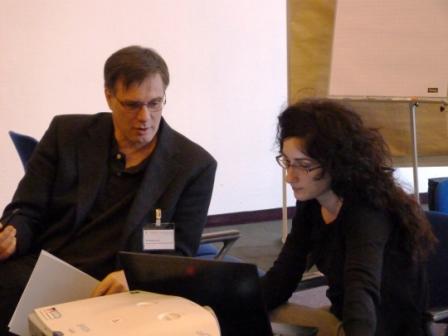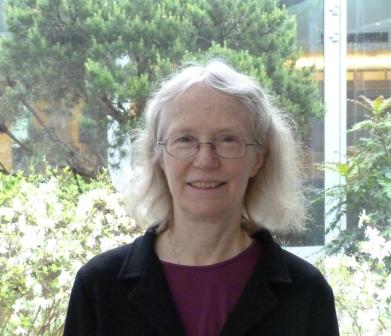Search Results for Tag: Potsdam
Climate impacts should spur emissions curb
- Professor Wolfgang Lucht and Ioanna Mouratiadou at a session on “What’s still missing” to address climate impacts
Here in Potsdam at the Impacts World 2013, I have been searching for the links between climate impacts research and political action to curb emissions. I have talked to a lot of the scientists present from different parts of the world about this, both in the sessions and one-to-one. My concern is that the increasing focus on adaptation to cope with the effects of climate change could detract from awareness of the need for urgent political action. Professor Wolfgang Lucht , who’s in charge of Earth System Analysis at the Potsdam Institute for Climate Impacts Research PIK) and Professor of Sustainability Studies at Berlin’s Humboldt-University told me he thinks the very opposite is the case. He is convinced the evidence being amassed on the impacts of climate change will strengthen the case for stricter emissions targets. He is convinced better networking of the available data will help provide politicians with the material they need to get on with both mitigation and adaptation.
Cynthia Rosenzweig is head of the Climate Impacts Group at the NASA Goddard Institute for Space Studies. She says Hurricane Sandy was a kind of “tipping point” in awareness of the possible effects of climate change and the links to extreme weather events. She had been advising the city of New York on climate for 15 years before that. The interest, unsurprisingly, has intensified considerably.
She is also pushing very hard for better linking of different models, especially relating to the future of agriculture, and ultimately food security for the future. She introduced the conference to “AgMIP”, not a really catchy acronym, but easier than “The Agricultural Model Intercomparison and Improvement Project”. This whole conference is moving around better integration of information, better links and networks. The image of the “food web” came to me, which replaced the old “food chain”. Models at global level, domestic, regional, local, scientific bodies, ngos, governments, local authorities, have to be woven together to pool their knowledge – but in such a way that individual actors can access the info they need. A challenge indeed. There are also those here who say global scientific climate models have little relevance to adaptation to the effects of climate change on the ground. I am with Professor Lucht, who says we need the global models and the two degree target as a framework for the rest.
Climate Impacts World in Potsdam
- Artist in residence makes a visual summary of the discussion.
Potsdam, around half an hour from Berlin, is the home of the Potsdam Institute for Climate Impact Research (PIK), which has become one of the world’s leaders in its field. This week , the Institute is co-hosting “Impacts World 2013”, an “International Conference on Climate Change Effects”, along with the International Institute for Applied Systems Analysis.
I suppose you could describe climate impact research as a kind of bridge between climate science and what it means for the rest of us.
Droughts, floods, health risks, crop failures – there seem to be few areas of our lives where climate change does not have an impact.
There is a whole myriad of climate models, using different parameters and scenarios and focussing on different sectors. The ambitious aim of this gathering is to bring scientists and decision-makers together to try to understand how different sectors relate to each other and find ways of “joining the dots”..
Let me just share a couple of insights or thoughts with you that I picked up in the course of the day.
We need to bring the mass of information together in ways that make it possible for society to be prepared for extreme events and to cope with changing availability of water, different growing conditions, coastal erosion, sea-level rise.
Global trends in temperature rise are one thing – the impacts on the ground will be very different in different parts of the globe. Fitting the parts of the jigsaw together is a huge challenge.
Scientists themselves (this is based not only on the official sessions but conversations in the coffee breaks) are often confused by the differences in climate models and predictions. Slight changes to parameters can lead to hugely different results.
Feeding information from impact researchers “on the ground” back into models seems highly desirable but does not always happen.
There has been a lot of talk about communication. Some scientists think their job is to “do science”, not communicate with politicians or the public. Others want to communicate but are not very good at it. Some are very good at it and appear frequently in the media. My colleague Fiona Harvey from the Guardian, who chaired a debate on “Are the products of climate impact research really useful?” argued that all scientists should communicate their knowledge and not leave it up to a talented few. Otherwise, those who make the headlines may not be the ones who represent the consensus view. Indeed!
The media came in for a lot of stick as usual. We do have a huge influence and with it, a huge responsibility to get things right. My appeal to the scientific community – please do not put us all in the same boat. Not all of us are out to find sensations and just headlines that will attract the most attention whether they are accurate or not.
That is why I will head back into the conference and listen to more talk of the “Inter-sectoral impact model intercomparison project”, “Community-driven syntheses of climate change impact analyses”, “projection of global soil carbon dynamics”, “global multi-model perspectives on the potential and limitations of irrigation…” with the ultimate aim of finding out more about the impacts of climate change on or societies today and tomorrow. Then I will continue to try to explain it to those who rely on the media for relevant information in words they can understand…



















Feedback